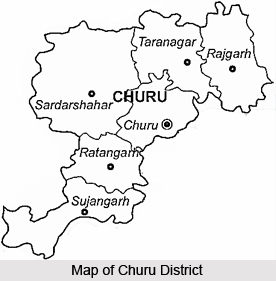 Administration of Churu District is carried out by the District Collector and District Magistrate who are at the head of District administration. The Additional District Magistrate and the Chief Executive Officer, Zila Parishad, are the two main helping hands at the district headquarters. As per the size and need of the citizens, the district has been divided into five sub divisions. A Sub Divisional Officer (SDO) works at the sub division level to provide support and leadership to the administrative system at the local level. The five sub divisions in the district of Churu are: Churu, Sujangarh, Ratanagarh, Sardarshahar and Rajgarh.
Administration of Churu District is carried out by the District Collector and District Magistrate who are at the head of District administration. The Additional District Magistrate and the Chief Executive Officer, Zila Parishad, are the two main helping hands at the district headquarters. As per the size and need of the citizens, the district has been divided into five sub divisions. A Sub Divisional Officer (SDO) works at the sub division level to provide support and leadership to the administrative system at the local level. The five sub divisions in the district of Churu are: Churu, Sujangarh, Ratanagarh, Sardarshahar and Rajgarh.
There are six tehsil headquarters in this district. Each one has a Tehsildar as the administrative officer, who works in accordance with the land-record system to serve rural farmers and land-holders. The tehsils of the district are: Churu, Sujangarh, Ratangarh, Sardarshahar, Rajgarh and Taranagar. A tehsil contains a number of "Patwar-Mandals", each of which has a `Patwari` to serve the landholders and farmers at the village level. There is one Additional tehsil - Bidasar and two Sub tehsils - Bhanipura and Sidhmukh.
Churu district is divided into 6 blocks (Panchayat Samitis) for the purpose of implementing and coordinating various developmental schemes. Each block has a Block Development Officer (BDO) to serve as an extension and developmental executive at the block level.
The six blocks of the Churu district are:
1. Churu
2. Sujangarh
3. Ratangarh
4. Sardarshahar
5. Rajgarh
6. Taranagar
Various development works and projects at the rural level (Gram Panchayat Level) are run through Block offices. One Gram Sevak is appointed at each Gram Panchayat to keep record of the development works and to project required development works. "Gram Sabha" (Village Meetings) are organized at fixed intervals to discuss about development of villages. There are 249 Gram Panchayats in the district. Due weightage has been given to public representatives in Panchayat Raj Institutions at each level.
This article is a stub. You can enrich by adding more information to it. Send your Write Up to content@indianetzone.com






